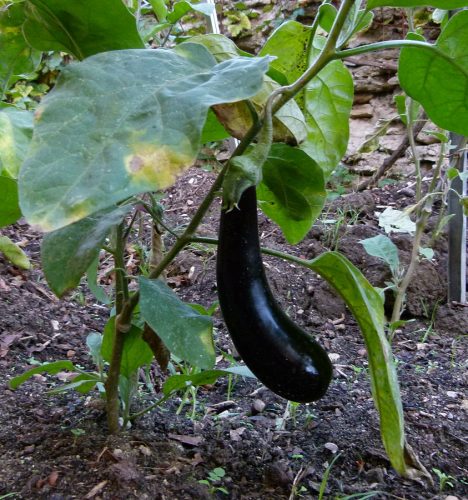Aubergine is a plant in the nightshade family.
Also known as:
Eggplant (US, Canada)
Brinjal (Asia)
You are viewing the mobile-adapted version of the page.
The one for tablets, laptop and desktop also provides general information, such as origin and cultivation.
Aubergine (Solanum melongena, also Solanum esculentum) is a plant in the nightshade family (Solanaceae). Both the plant and its fruit are called Aubergine. Because Aubergines need heat – these plants hardly grow at all below 20°C – they are best grown in a greenhouse or conservatory. Sow in February in greenhouse or windowsill, mid-June in the garden; harvest in August.
In young plants, remove (pinching) the offshoots in the leaf axils. Aubergines love a support in the form of a bamboo stick. Instead of sowing, it is sometimes easier to buy ready-grown plants at the garden center.
Keep checking Aubergines for slugs. In July, the first flowers appear, and in August, harvesting can take place.
Bugs
Leaves are eaten away: snails and slugs.
Curled leaves; here and there is an aphid of about 2 mm size: green peach aphid (Myzus persicae).
Deformities, deformed leaf: European tarnished plant bug (Lygus rugulipennis).
Fungi & diseases
Brown spots with grey mold: Gray mold (Botrytis ssp.).
Plant wilts and leaves turn yellow on one side. White (sometimes pink) mold develops on stem and tendrils: Fusarium wilt (Fusarium oxysporum).
Wet, rotten spots at the bottom of the stem: Fusarium foot rot (Fusarium solani).
The fine roots wear away and rot: Pythium root rot (Pythium spp.).
Leaves at the end of a stem wilt, with the leaf not curling or coiling. Then more top leaves follow. A cut affected stem shows bacterial slime: Ralstonia solanacearum.
Other
Leaf stalks grow from leaf axils: offshoots inadequately removed – pinching.

